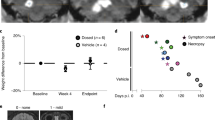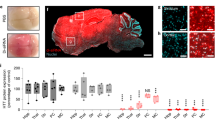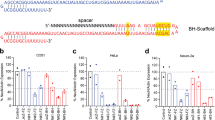Abstract
RNA interference (RNAi) is a powerful strategy for unraveling gene function and for drug target validation, but exogenous expression of short hairpin RNAs (shRNAs) has been associated with severe side effects. These may be caused by saturation of the microRNA pathway. This study shows degenerative changes in cell morphology and intrusion of blood vessels after transduction of the ventromedial hypothalamus (VMH) of rats with a shRNA expressing adeno-associated viral (AAV) vector. To investigate whether saturation of the microRNA pathway has a role in the observed side effects, expression of neuronal microRNA miR-124 was used as a marker. Neurons transduced with the AAV vector carrying the shRNA displayed a decrease in miR-124 expression. The decreased expression was unrelated to shRNA sequence or target and observed as early as 1 week after injection. In conclusion, this study shows that the tissue response after AAV-directed expression of a shRNA to the VMH is likely to be caused by shRNA-induced saturation of the microRNA pathway. We recommend controlling for miR-124 expression when using RNAi as a tool for studying (loss of) gene function in the brain as phenotypic effects caused by saturation of the RNAi pathway might mask true effects of specific downregulation of the shRNA target.
This is a preview of subscription content, access via your institution
Access options
Subscribe to this journal
Receive 12 print issues and online access
$259.00 per year
only $21.58 per issue
Buy this article
- Purchase on Springer Link
- Instant access to full article PDF
Prices may be subject to local taxes which are calculated during checkout



Similar content being viewed by others
References
Bish LT, Sleeper MM, Reynolds C, Gazzara J, Withnall E, Singletary GE et al. Cardiac gene transfer of short hairpin RNA directed against phospholamban effectively knocks down gene expression but causes cellular toxicity in canines. Hum Gene Ther 2011; 22: 969–977.
Grimm D, Streetz KL, Jopling CL, Storm TA, Pandey K, Davis CR et al. Fatality in mice due to oversaturation of cellular microRNA/short hairpin RNA pathways. Nature 2006; 441: 537–541.
Borel F, van Logtenstein R, Koornneef A, Maczuga P, Ritsema T, Petry H et al. In vivo knock-down of multidrug resistance transporters ABCC1 and ABCC2 by AAV-delivered shRNAs and by artificial miRNAs. J RNAi Gene Silencing 2011; 7: 434–442.
Ahn M, Witting SR, Ruiz R, Saxena R, Morral N . Constitutive expression of short hairpin RNA in vivo triggers buildup of mature hairpin molecules. Hum Gene Ther 2011; 22: 1483–1497.
McBride JL, Boudreau RL, Harper SQ, Staber PD, Monteys AM, Martins I et al. Artificial miRNAs mitigate shRNA-mediated toxicity in the brain: Implications for the therapeutic development of RNAi. Proc Natl Acad Sci 2008; 105: 5868–5873.
Martin JN, Wolken N, Brown T, Dauer WT, Ehrlich ME, Gonzalez-Alegre P . Lethal toxicity caused by expression of shRNA in the mouse striatum: implications for therapeutic design. Gene Therapy 2011; 18: 666–673.
Boudreau RL, Martins I, Davidson BL . Artificial microRNAs as siRNA shuttles: improved safety as compared to shRNAs in vitro and in vivo. Mol Ther J Am Soc Gene Ther 2009; 17: 169–175.
Ulusoy A, Sahin G, Björklund T, Aebischer P, Kirik D . Dose optimization for long-term rAAV-mediated RNA interference in the nigrostriatal projection neurons. Mol Ther J Am Soc Gene Ther 2009; 17: 1574–1584.
Khodr CE, Sapru MK, Pedapati J, Han Y, West NC, Kells AP et al. An alpha-synuclein AAV gene silencing vector ameliorates a behavioral deficit in a rat model of Parkinson’s disease, but displays toxicity in dopamine neurons. Brain Res 2011; 1395: 94–107.
Ehlert EM, Eggers R, Niclou SP, Verhaagen J . Cellular toxicity following application of adeno-associated viral vector-mediated RNA interference in the nervous system. Bmc Neurosci 2010; 11: 20.
Sledz CA, Holko M, de Veer MJ, Silverman RH, Williams BRG . Activation of the interferon system by short-interfering RNAs. Nat Cell Biol 2003; 5: 834–839.
Jackson AL, Bartz SR, Schelter J, Kobayashi SV, Burchard J, Mao M et al. Expression profiling reveals off-target gene regulation by RNAi. Nat Biotechnol 2003; 21: 635–637.
Tiesjema B, la Fleur SE, Luijendijk MCM, Adan RAH . Sustained NPY overexpression in the PVN results in obesity via temporarily increasing food intake. Obesity (Silver Spring) 2009; 17: 1448–1450.
De Backer MWA, la Fleur SE, Adan RAH . Both overexpression of agouti-related peptide or neuropeptide Y in the paraventricular nucleus or lateral hypothalamus induce obesity in a neuropeptide- and nucleus specific manner. Eur J Pharmacol 2011; 660: 148–155.
Frayling TM, Timpson NJ, Weedon MN, Zeggini E, Freathy RM, Lindgren CM et al. A common variant in the FTO gene is associated with body mass index and predisposes to childhood and adult obesity. Science 2007; 316: 889–894.
Bridge AJ, Pebernard S, Ducraux A, Nicoulaz A-L, Iggo R . Induction of an interferon response by RNAi vectors in mammalian cells. Nat Genet 2003; 34: 263–264.
Yi R, Doehle BP, Qin Y, Macara IG, Cullen BR . Overexpression of exportin 5 enhances RNA interference mediated by short hairpin RNAs and microRNAs. RNA 2005; 11: 220–226.
Tung Y-CL, Ayuso E, Shan X, Bosch F, O’Rahilly S, Coll AP et al. Hypothalamic-specific manipulation of Fto, the ortholog of the human obesity gene FTO, affects food intake in rats. PLoS One 2010; 5: e8771.
Hayes MR, Skibicka KP, Leichner TM, Guarnieri DJ, DiLeone RJ, Bence KK et al. Endogenous leptin signaling in the caudal nucleus tractus solitarius and area postrema is required for energy balance regulation. Cell Metab 2010; 11: 77–83.
Choi DL, Davis JF, Magrisso IJ, Fitzgerald ME, Lipton JW, Benoit SC . Orexin signaling in the paraventricular thalamic nucleus modulates mesolimbic dopamine and hedonic feeding in the rat. Neuroscience 2012; 210: 243–248.
Hommel JD, Trinko R, Sears RM, Georgescu D, Liu Z-W, Gao X-B et al. Leptin receptor signaling in midbrain dopamine neurons regulates feeding. Neuron 2006; 51: 801–810.
Yi R, Qin Y, Macara IG, Cullen BR . Exportin-5 mediates the nuclear export of pre-microRNAs and short hairpin RNAs. Genes Dev 2003; 17: 3011–3016.
Lund E, Güttinger S, Calado A, Dahlberg JE, Kutay U . Nuclear export of microRNA precursors. Science 2004; 303: 95–98.
Diederichs S, Jung S, Rothenberg SM, Smolen GA, Mlody BG, Haber DA . Coexpression of Argonaute-2 enhances RNA interference toward perfect match binding sites. Proc Natl Acad Sci USA. 2008; 105: 9284–9289.
Grimm D, Wang L, Lee JS, Schürmann N, Gu S, Börner K et al. Argonaute proteins are key determinants of RNAi efficacy, toxicity, and persistence in the adult mouse liver. J Clin Invest 2010; 120: 3106–3119.
de Backer MW, Brans MA, van Rozen AJ, van der Zwaal EM, Luijendijk MC, Garner KG et al. Suppressor of cytokine signaling 3 knockdown in the mediobasal hypothalamus: counterintuitive effects on energy balance. J Mol Endocrinol 2010; 45: 341–353.
Broekman MLD, Comer LA, Hyman BT, Sena-Esteves M . Adeno-associated virus vectors serotyped with AAV8 capsid are more efficient than AAV-1 or -2 serotypes for widespread gene delivery to the neonatal mouse brain. Neuroscience 2006; 138: 501–510.
Kan AA, van Erp S, AAHA Derijck, de Wit M, Hessel EVS, O’Duibhir E et al. Genome-wide microRNA profiling of human temporal lobe epilepsy identifies modulators of the immune response. Cell Mol Life Sci Cmls 2012; 69: 3127–3145.
Acknowledgements
This work was supported by TIPharma, project T5-210-1, and by a VIDI grant from the Netherlands Organization for Health Research and Development and a grant from Neuroscience and Cognition Utrecht (to RJP). We acknowledge Eljo van Battum, Rudolf Magnus Institute of Neuroscience, for her technical assistance and Dr Joost Verhaagen, Netherlands Institute for Neuroscience, for critically reading the manuscript.
Author information
Authors and Affiliations
Corresponding author
Ethics declarations
Competing interests
The authors declare no conflict of interest.
Additional information
Supplementary Information accompanies this paper on Gene Therapy website
Rights and permissions
About this article
Cite this article
van Gestel, M., van Erp, S., Sanders, L. et al. shRNA-induced saturation of the microRNA pathway in the rat brain. Gene Ther 21, 205–211 (2014). https://doi.org/10.1038/gt.2013.76
Received:
Revised:
Accepted:
Published:
Issue Date:
DOI: https://doi.org/10.1038/gt.2013.76
Keywords
This article is cited by
-
Toxicity after AAV delivery of RNAi expression constructs into nonhuman primate brain
Nature Medicine (2021)
-
MicroRNAs as regulators of brain function and targets for treatment of epilepsy
Nature Reviews Neurology (2020)
-
Enhancement of gene knockdown efficiency by CNNC motifs in the intronic shRNA precursor
Genes & Genomics (2019)
-
A hippocampus to prefrontal cortex neural pathway inhibits food motivation through glucagon-like peptide-1 signaling
Molecular Psychiatry (2018)
-
Reducing Ventral Tegmental Dopamine D2 Receptor Expression Selectively Boosts Incentive Motivation
Neuropsychopharmacology (2015)



